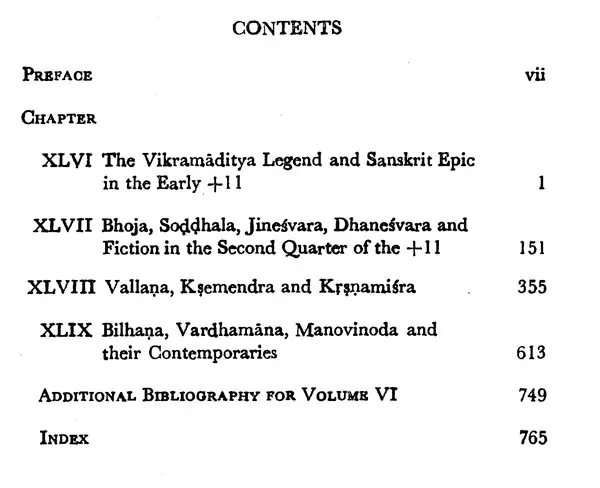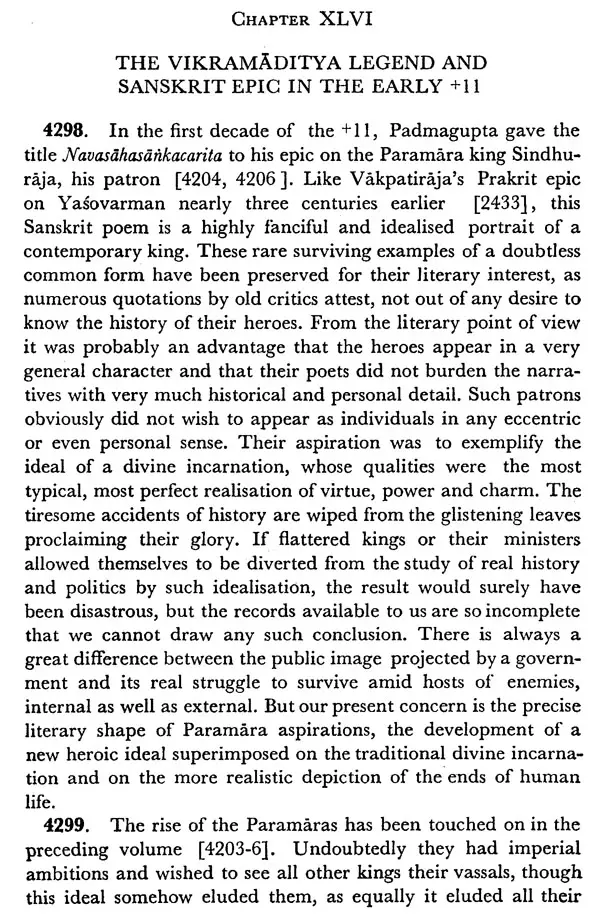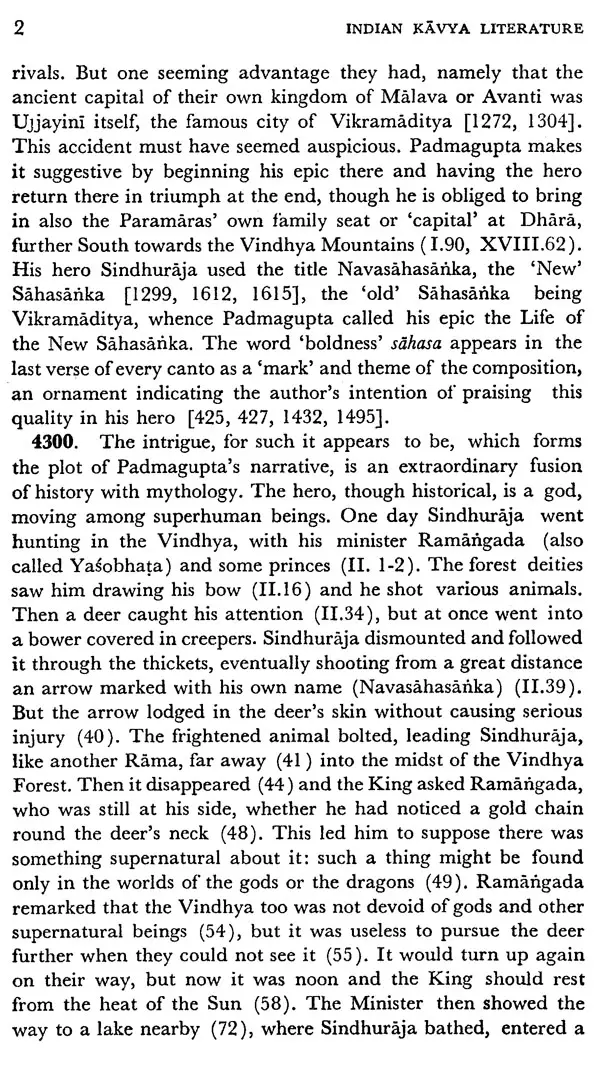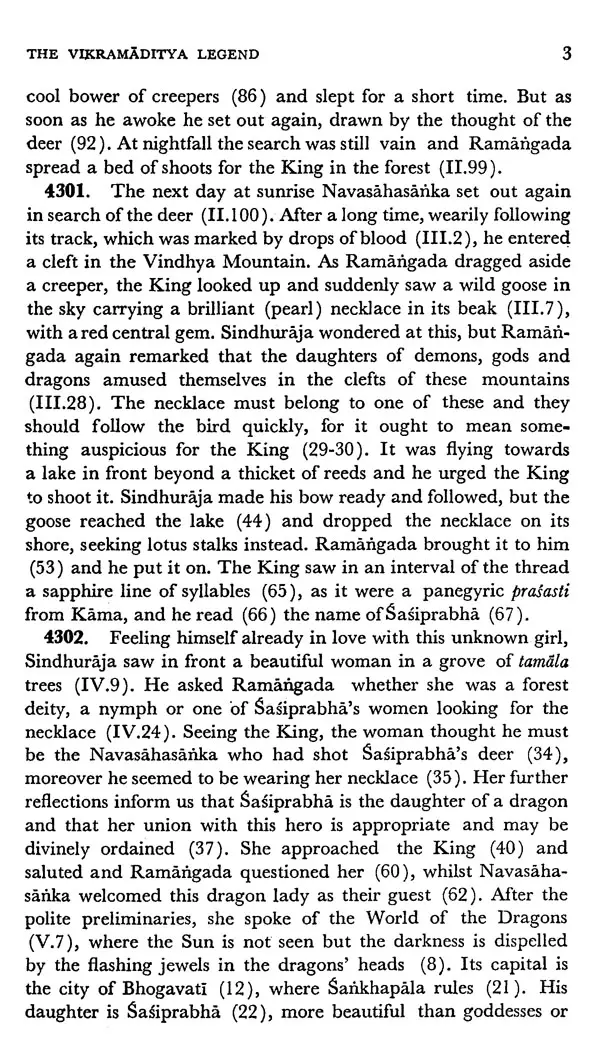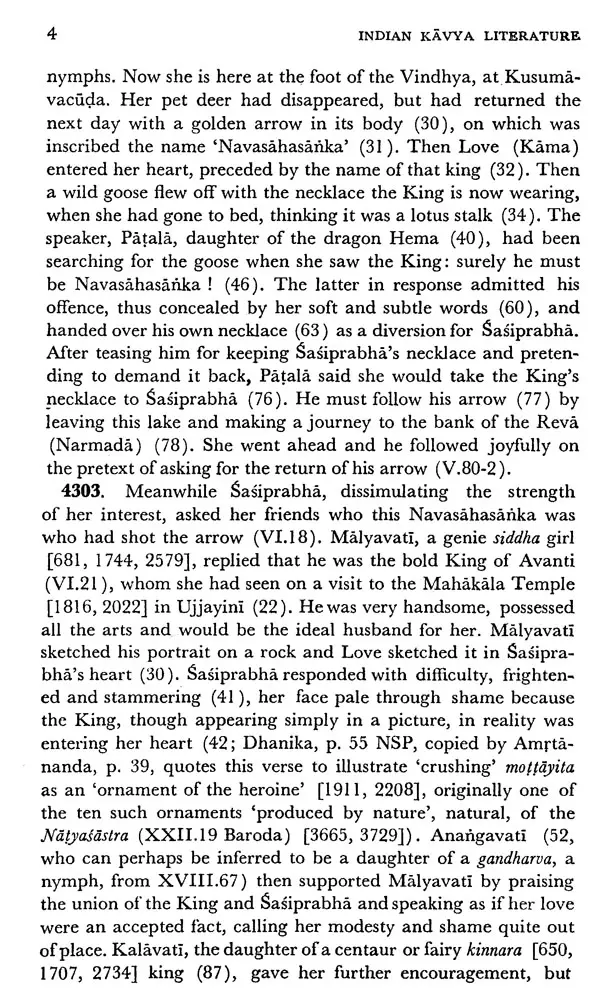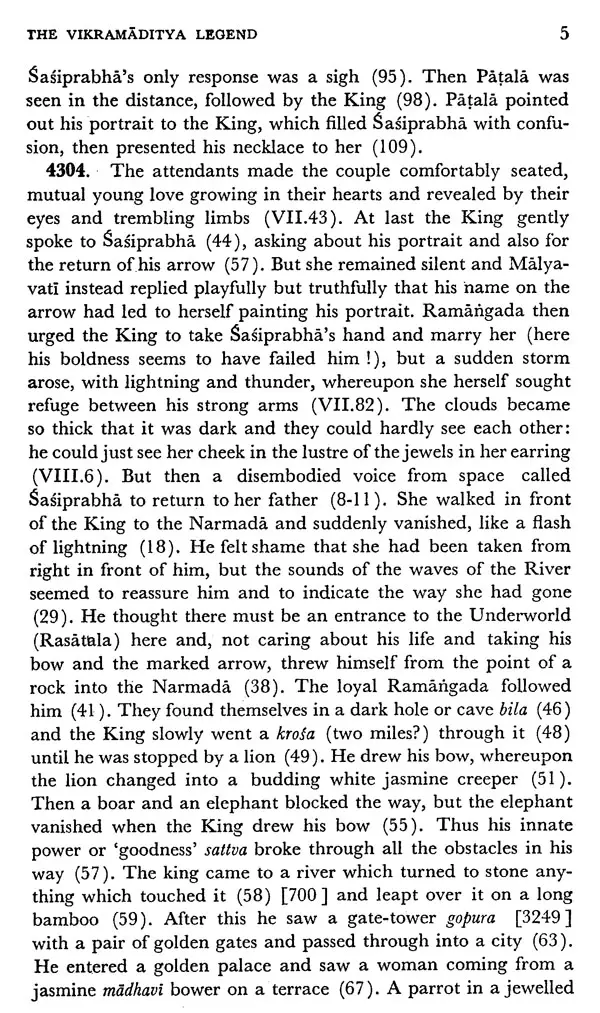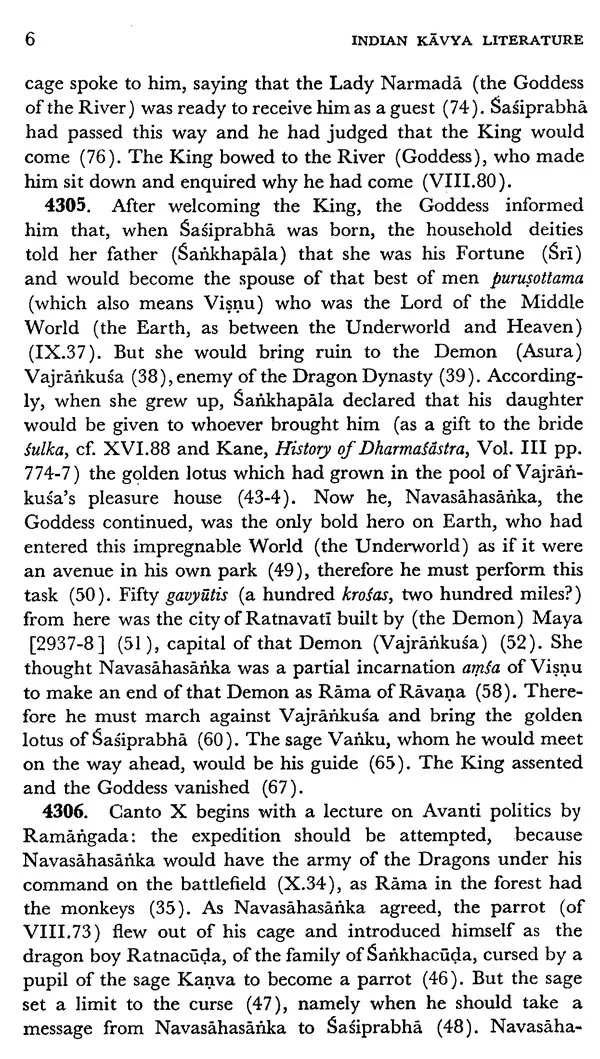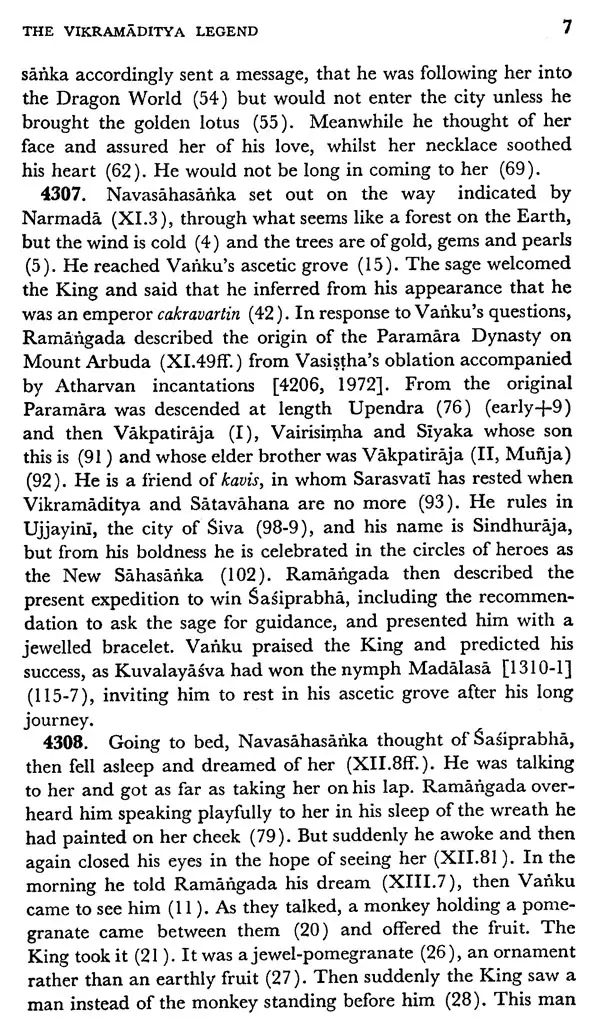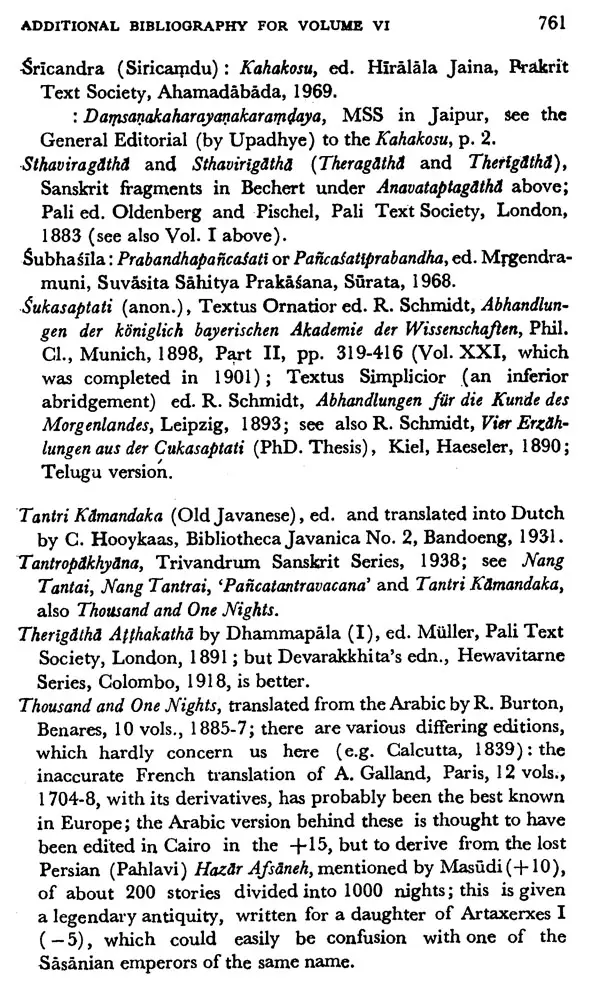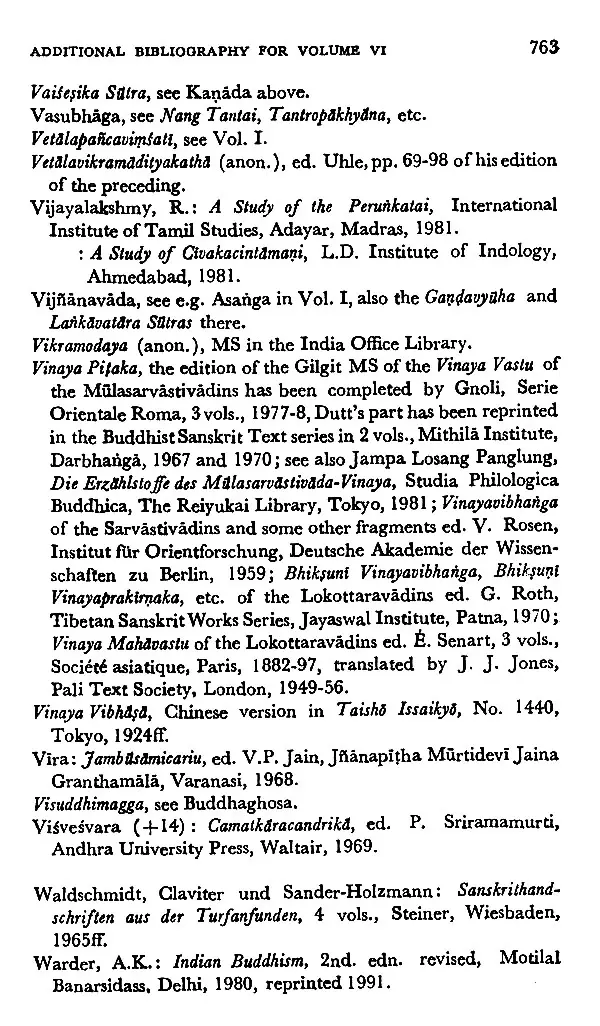
Indian Kavya Literature : The Art of Storytelling (Volume-6)
Book Specification
| Item Code: | IDG342 |
| Author: | A. K. Warder |
| Publisher: | Motilal Banarsidass Publishers Pvt. Ltd. |
| Edition: | 1992 |
| ISBN: | 8120804358 |
| Pages: | 865 |
| Cover: | Hardcover |
| Other Details | 8.5" X 5.5" |
| Weight | 1.05 kg |
Book Description
Volume VI continues the exploration of Indian Literature (Kavya) into the eleventh century, from Padmagupta and Atula to Bilhana and Manovinoda. The reason why this one century appears to occupy a whole volume here is hinted in the sub-title, for the volume contains substantial retrospects over storytelling in earlier centuries. A little of this has been touched on in previous volumes, but its development is obscured by difficulties of chronology and especially by the fact that we can rarely say an extant version of a story is the original one. In the Vedic tradition we look back from the Vikramaditya cycle [4392-4] as known in the eleventh century to the stories connected with Nanda, including the presumed original of the Thousand and One Nights, and Sudraka. In the Buddhist tradition, from Ausa [4842] and Ksemendra [5017] in the same century we are looking at cycles associated with Bimbisara [4395], Asoka, Kaniska [4397] and Satavahana [4398]. In the Jaina tradition [4630ff.] we find Jaina versions of many of these stories. All three seem to lay equal claim to Udayana [1395], but the Jainas leave him a minor figure in the time of Bimbisara-Srenika [4665].
Since these stories have collected round the names of historical kings, one might suppose we are concerned here with history, not fiction. But the fact is that from Bimbisara to Vikramaditya there is very little in these legends which a historian would credit. In the stories fancied to be told to them and the anecdotes, for such they are, told about them, there is hardly an episode which is not stark fiction, including marvels and miracles believed produced by forces from past lives, even science fiction such as transmutation into gold (Satavahana).
The historical peg merely induces belief and enjoyment, for all the stories, except one, are presented as true. Their 'truth', we can say, is rather an aesthetic truth where a 'good' story is a beautiful story, that is an entertaining, usually amusing, story, but with a 'moral': a universal truth is shown by the particular example
In the eleventh century besides what seems to be the culminating point of the storytelling tradition (Bhoja, Ksemendra, Somadeva, etc.), there are a number of surviving long novels, by Soddhala, Jinesvara, Dhanesvara and Vardhamana. Even epics (e.g. Padmagupta's) seem to be assimilated to fiction, and that even when extracted from Tradition (Laksmidhara) The Jaina narratives of jinas and the like, supposed to be historical, are likewise subject to the all-pervading influence of fiction (Bhavacandra, Gunapala).
Beyond the scope of this influence, the rich imagination of the lyric poet Vallana composed verses in the best, and original, tradition of Kavya. Among the rare dramas surviving from the eleventh century is Krsnamisra's allegorical religious play personifying Vedic categories and the virtues, led by Discrimination, and vices, led by elusion.
About the Author:
Dr. Warder is Professor Emeritus of Sanskrit in the University of Toronto. He is the author of 15 books and more than 30 articles on Indology, mostly literature and philosophy, and co-author or editor 7 more. He has spent several years in India exploring manuscript libraries in every state in connection with his work on kavya.
Excerpts from Review:
.of a far broader scope . Three points are stressed: (1) the necessity to present kavya literature in its own terms; (2) an attempt to improve our knowledge of its chronology; (3) emphasis on the interrelation between the positions of kavya composers and the social and cultural history of India.
Journal of the American Oriental Society
L. ROCHER
His treatment of Indian literature is sympathetic and intimate, using both printed texts and works available only in manuscript form; he tries to evaluate the texts from the point of view of Indian aesthetic criticism Prof. Warder is always original in his approach, and his views are based on first hand information.
Adyar Library Bulletin
K. K. RAJA
.breaks a good deal of new ground .and is novel in its approach and ambitious in its execution .It has been Professor Warder's aim in these volumes to judge the literary products in Sanskrit, Prakrit and other cognate languages according to the standards of 'contemporary criticism' . Deserves our hearties congratulations for this sustained and intensive study .
Bulletin of the Ramakrishna Mission
B. BHATTACHARYA
The merit of this series lies in the originality of approach . Prof. Warder points out to us that thousands of manuscripts remain to be collected .has gone to the original sources and has not depended on secondary sources. The volumes have been enriched by numerous quotations in English translation.
Journal of the Indian Musicological Society
R.C.M.
If he is able to succeed in his laudable effort, it is not only because of sincerity of purpose but also because of his first-hand knowledge of this vast Kavya literature and the important works on Indian literary theories . This magnificent work written by an erudite scholar of unbiased into Indian literature .
Journal of the Sanskrit Academy
P.S.R
Storytelling seems to dominate +11 kavya, in the first place because such famous collections as those of Ksemendra and Somadeva II are of that century, though the original stories are earlier. There are also many less known collections made at that time, particularly by Jaina authors, and some Buddhist collections are supposed to have been introduced to Tibet in that century (Dipankararijnana). Bhoja made a small collection and perhaps refers to the Sukasaptati in some form. The Old Javanese Tantri Kamandaka and Durgasimha’s Kannada ‘Pancatantra’, both dated in the +11, draw attention to the Tantropakhyana, indicating however that the original is much earlier.
All this focuses interest on the development of a great art form, whose earlier chronology is mostly vague. The origin of any particular story can never be found, though versions of it may sometimes be dated. Even if it is told of a historical person (e.g. Kaniska), it may be a mere transfer from an earlier person (e.g. Asoka). At most, then, one could describe the art of an individual writer retelling an old story, but that may be a little premature until more stories have been printed, compared and thoroughly analyzed. Here we had scope only for a first impression, for a general idea of the form which may show how it entertains and instructs.
In the + 11 we find a good many longer stories or novels, especially Soddhala’s and Dhandvara’s, more elaborate fictions of complex construction, based on mysteries. But some among these, such as Jindvara’s and Vardhamana’s, have emboxed stories told by characters, or even brief episodes from their past lives which resemble short stories or are actually versions of older stories of other heroes. Short stories are sometimes einboxed in what are presented as historical narratives, for example by Gunapala (5385-96) and Bhãvacandra [5207).
Epic poems too seem to be affected by the pervasion of fiction, as well as by the Vikramãditya legend. Padinagupta’s purports to be part of the biography of his Paramara patron, but the story is so much like a novel that it is hard to believe it as history, even after subtracting embellishments fancied on the basis of royal families claiming descent from Dragons and Wizards or of enemies supposed to be demons asuras. Lakmidhara’s story of Usã and Aniruddha [4822-37], though following the Harivamsa closely and enclosed in Krsna’s war with Bãna (and Siva), is again a novelistic intrigue, extracted from Tradition. Bilhana’s biography of a Calukya is only a superficial parallel to Padmagupta, there being no intrigue. The very tides Navasahasankacarita and Vikramdnkadevacarita proclaim Vikramaditya as model for a king in this period. Atula we have found possibly influenced indirectly by the chronological distortion reflecting Vikramâditya’s being moved back into Pur5siic antiquity [4369].
The drama seems inconspicuous in this century, as if the fewness of the surviving examples reflects a real diversion of interest into storytelling. But this may be accidental.
From datable texts of the + 11 we are led to a retrospective of storytelling where the legend and ‘Cycle’ of Vikramaditya are preceded by stories about or told to other famous kings who passed from history into legend. Disregarding Yudhiahira or Janamejaya (descendant of Arjuna, to whom Vaisampayana recited the Bhdrata), let alone Siva, we start with Bimbisara, whose date appears to coincide with the origins of kavi’a [561, 4395, 4634, 4664-5, 5023-5, etc.]. Heis followed by Udayana [5026], Nanda [4396, 4657-9), Aoka [4397, 4778, 5018) and we might add Muladeva as the last Maurya prince [1142, 1218, 1367, 2677, 4491, 4524, 4565, 4959, 5509]. Dutthagâmani in Ceylon should be inserted here [5016, 5095, 5137ff.], then we have Kaniska [4397], Satavahana [4398, 44ff.1 and udraka [4399]. After Vikramaditya [4385ff.) it is Bhoja [4399] in the + 11 again who will become the next legendary king.
Stories are usually true, if we are to believe their tellers, with possibly one exception in this volume, which we have called an anti-story [53951. The Jainas seem to ascribe all their traditional stories to the omniscience of the Jina, which should guarantee their truth, for they believed he had no need and certainly no motive for departing from the infinite recesses of history. The Buddhists similarly seem to ascribe their ancient stories to the omniscience of the Buddha, as jatakas and the like, whilst their more recent stories almost always have a historical setting: kings of India, Ceylon and so on are named as contemporaries and sometimes appear, or monks famous in the histories and commentaries of Ceylon are introduced. This does not exclude fabulous legends of monks visiting the heavens and gods paying their respects on Earth.
The Brahmanical or Saiva Tradition might seem less historical yet again we find the connections with famous kings though increasingly legendary such as Nanda and vikramaditya whilst Dandin we recall had denied the distinction at least in literature between history and fiction (427, 1966). Others of course maintained a contrary view including the Buddhists Amarasimha and Bhamaha (425) but the pressure to make everything true seems to be increasing. For example Bana writing a novel contrasting of historicity. The Brhatkatha of Gunadhya was attached to the history of Udayana and the kings of avanti though Naravahanadatta was evidently fictitious. Its Saiva version translated by Ksemendra and Somadeva II could accommodate any story (5210ff.)
It is clear that aesthetic often including moral truth transcends historical truth timelessness negates time classical truths here replace the facts more often the lies and baseless opinions of the ephemeral outpourings by what are today miscalled media which distort instead of communicating. The ephemeral pronouncements of medieval politicians and most religious teachers in India have not been preserved except in some inscriptions of kings (but cf. 5200). We may infer the religious distortions mainly form their effects the growing disharmony and divisions due to intolerance. But we posses a few classics of art which many people have treasured for many centuries. We of course leave aside as not kavya the agamas and sastras of religion which are usually professedly sectarian which usually reach beyond sectarian teaching to a wider consensus and to art. Buddhism is essentially philosophy not a religion though superficially popular Buddhism may sometimes resemble one opposed to revealed and authoritarian teachings.
So this is classical storytelling aimed at fixing truths in enduring form. Its aesthetics is the Indian tradition of the Natyasastra where art replaces the old religion to uphold truth and moral action. There is infinite variety of individual writers and there are many tradition of teachers but in art there appears a great consensus on what is good or probably we should say beautiful subha conduct. In India non violence, freedom, calm, constancy, courage, respect for others even for animals, compassion unselfishness or equality generosity toleration and truth itself seem to be aesthetic ideas of beautiful actions free from the ugly conflicts of religion. Humor also is an intrisincally aesthetic rather than religious emotion. Love again seems to be beautiful and the corresponding experience by detached spectators to be brilliant srngara or ujjvala that is an experience of something beautiful and delightful.
The novel or long story (436ff.) is usually a mystery resolved at the end (458). It is normally a single narrative though there may be subordinate sub plot which may have emboxed episodes later seen to be aprts of the main narrative (437). This narration will be unbroken by chapter divisions since it is for private reading not public recitation or performance. But there are exceptions to this especially in the entire stories which were intended for public recitation with a series of lives of souls in transmigration and really constitute a distinct type (450). Their content is a quest rather than a mystery though these overlap.
Disregarding the hybrid and didactic illustrating novel (452) which often contains emboxed stories not part of the main narrative illustrations told by characters to make points we are left with the short story itself. It is generally enclosed in a collection of some kind which may have a complex organization with a main narrative may be illustrating or may have a very slender frame of a storyteller or one or a series of occasions. The stories may also be classifiable as excellent (454) mysteries (455) or riddles (456).
